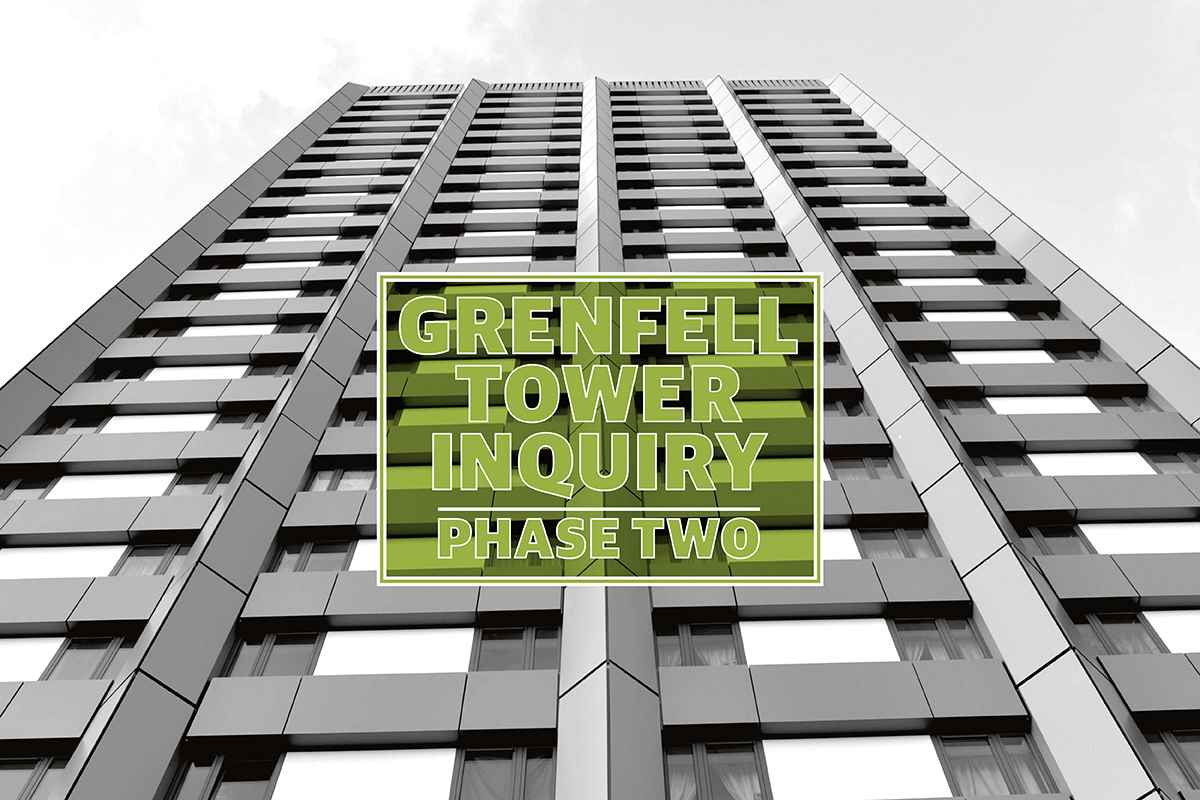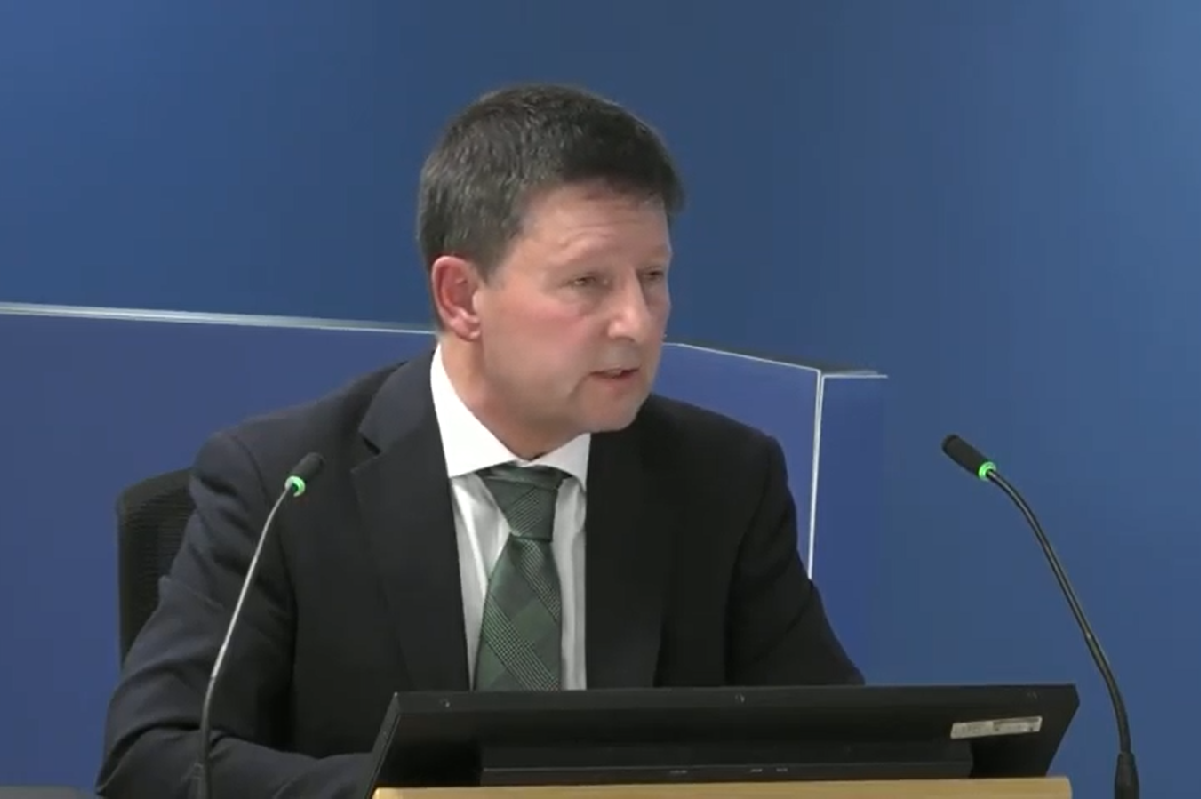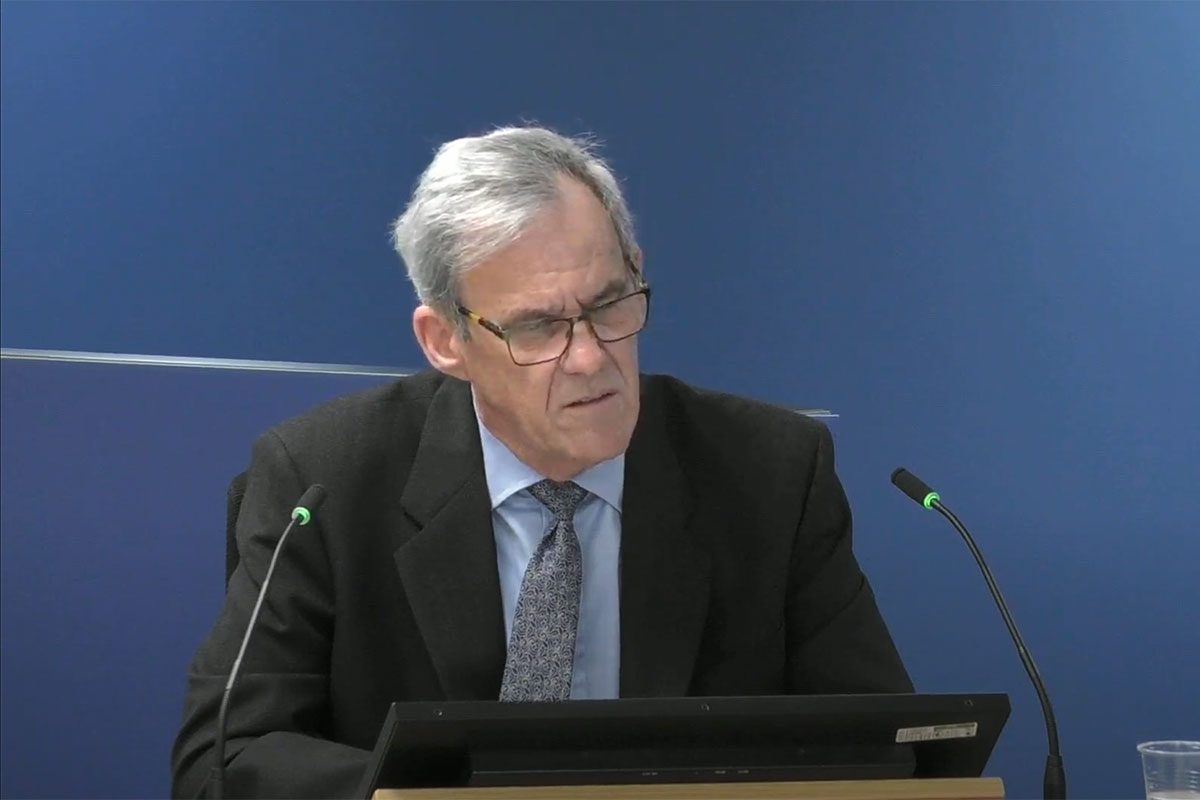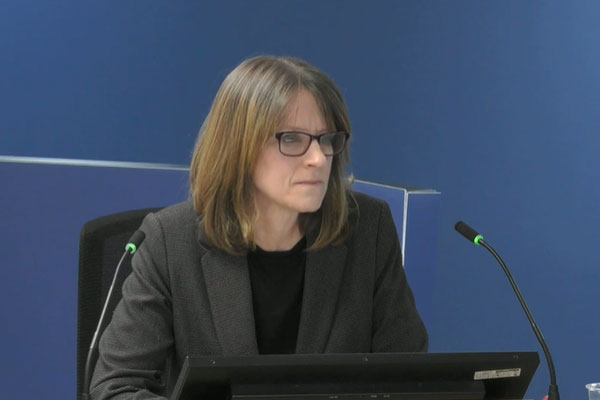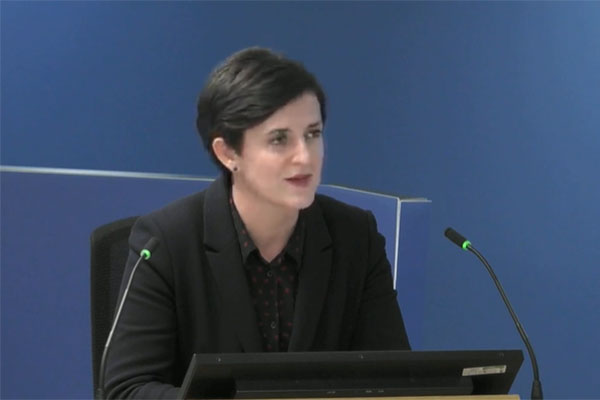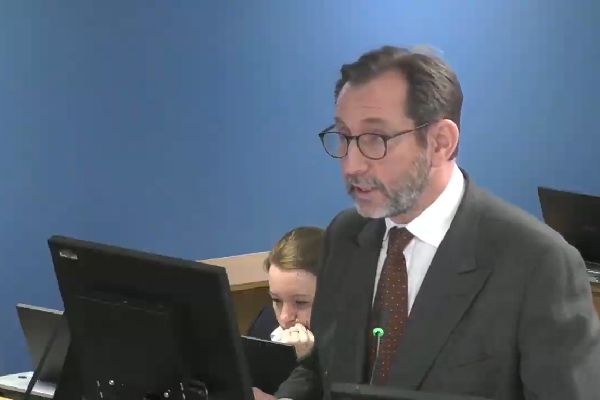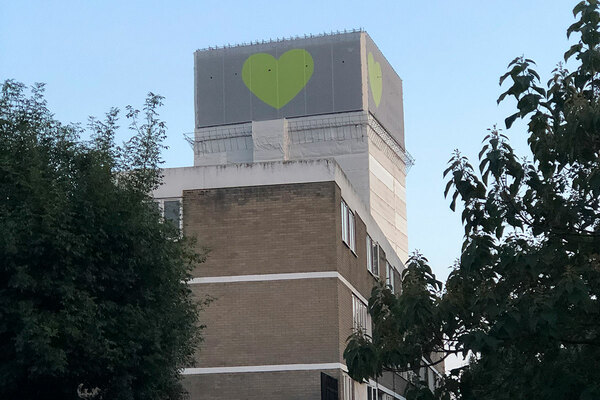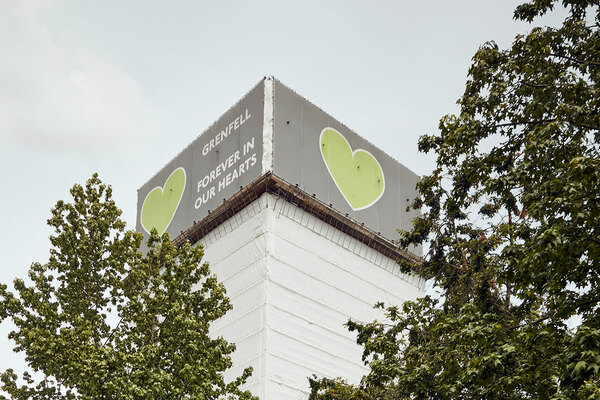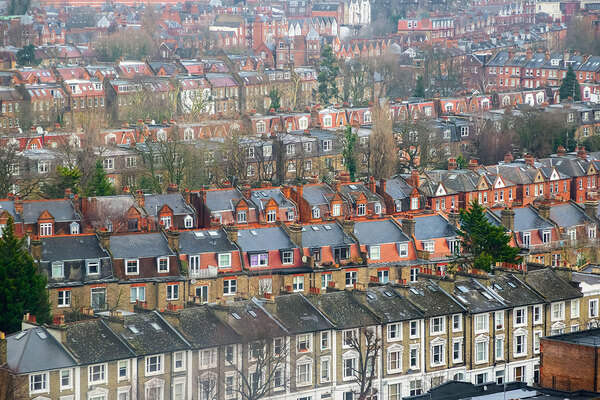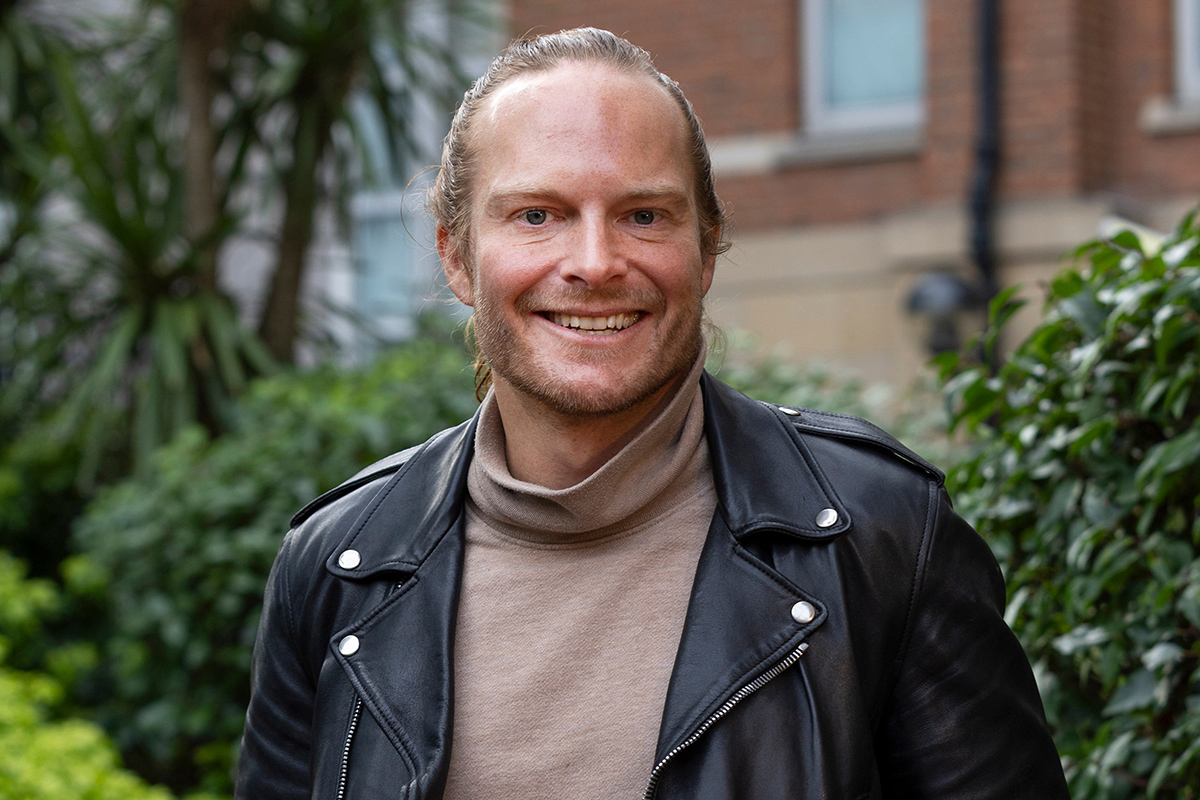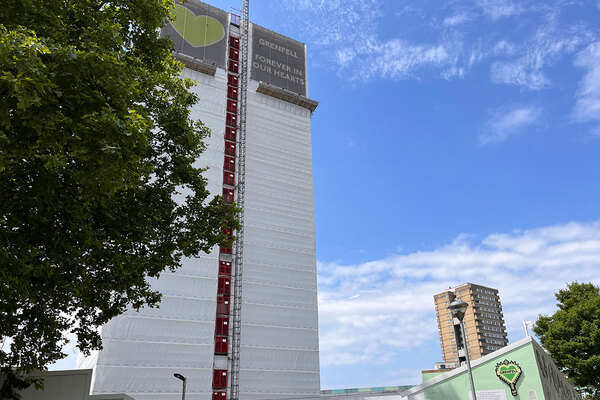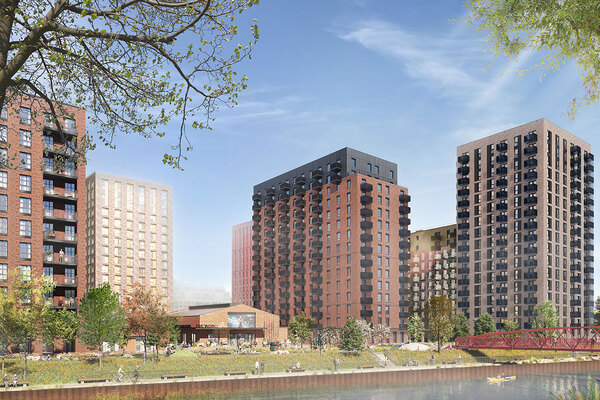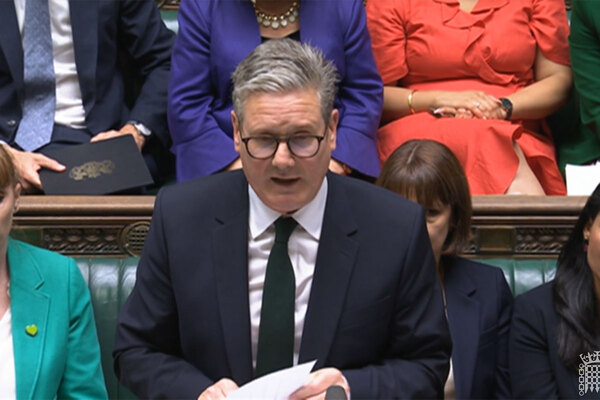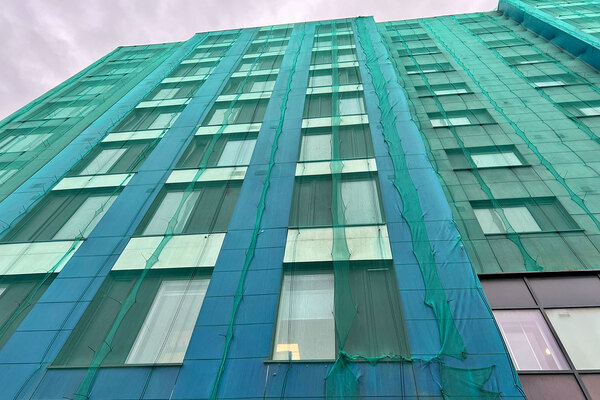Grenfell Tower Inquiry diary week 76: ‘I fear this will become our New Orleans’
This week the inquiry heard from central government figures and members of the London-wide emergency response arrangements. Peter Apps and Grainne Cuffe report
This week the Grenfell Tower Inquiry continued its exploration of the aftermath of the fire, with evidence from those who attempted to support the Royal Borough of Kensington and Chelsea’s (RBKC) response, as well as the first witness from central government.
The week began with the evidence of Mark Sawyer, chief executive liaison officer (resilience) at London Local Authority Gold (LLAG).
‘Looks like job done. Cheers’
Mr Sawyer (pictured above) worked within the complex structure that existed to offer support during major incidents affecting the capital.
But this operation could only step in if the local authority where the incident occurred requested it.
“There is no, as I’m aware, legal basis upon which Local Authority Gold can intervene in the affairs of an individual local authority. Therefore, it had to be a request rather than imposed,” he told the inquiry.
And as we have heard throughout this module, RBKC failed to request it. Nicholas Holgate, then-chief executive of the borough, rejected the advice of his emergency planner on the morning of the fire to do so, saying “that looks like we can’t cope”.
Mr Sawyer does not appear to have been unduly worried about this to begin with.
“Looks like job done. Cheers,” he wrote to colleagues at 8.18am on the morning of the fire, after hearing that RBKC had elected to keep control of the response.
“I would suggest that is likely to be the motivation behind that message, which was that it had been clarified that RBKC were leading the incident, there was no need for Local Authority Gold to actively be involved,” he said when asked about the email.
However, with concerns mounting throughout the day, Mr Sawyer was deployed to RBKC on 15 June, the day after the fire, to support its response. This was unusual.
“The fact that I believe I’ve done it twice in 15 to 20 years suggests it is unusual, and in both situations it was not as quickly as I was required to go in to RBKC, on the sort of 24/48 hours after,” he said.
He said it “started to hit home” throughout this day that RBKC was struggling to cope with the response.
“Were you trying to encourage, nudge, point towards areas to improve?” asked Demot Keating, counsel to the inquiry.
“That is a really good way of describing it,” Mr Sawyer replied. “And the other thing, whether right or wrong, I still felt I was a guest in RBKC – I had been allowed in, rather than having the authority to instruct and change.”
“Is a lesson that you’ve learned that you should have been more challenging in highlighting the extent to which RBKC were going wrong?” asked Mr Keating.
“Exactly, and testament to the fact that this was the first situation I had been involved with which required that level of assertion,” Mr Sawyer said.
‘They projected competence, professionalism, ability that I think in retrospect clearly was not backed up by action’
Following Mr Sawyer was John Barradell (pictured above), chief executive of City of London Council, who has been widely described as having stepped in to the role occupied by Mr Holgate once the London-wide response was belatedly activated on 16 June.
This, though, became a difficult topic because it is not what Mr Barradell said happened.
“Was it the case, to your understanding at the time, that once LLAG was activated, then the LLAG person, in this case it was you, took over and no longer supported but actually occupied the role of Gold previously occupied by Nicholas Holgate?” asked Richard Millett QC, lead counsel to the inquiry.
“Absolutely not,” replied Mr Barradell.
Instead, he said his role was to chair meetings in RBKC and that he “stood by them, not in their shoes”.
Katherine Hammond, a senior cabinet office civil servant who gave evidence later in the week, was among those to give different evidence on this point.
In her witness statement she said: “Mr Barradell took over responsibility for leadership of the recovery operation from Mr Holgate.”
“Was your understanding that he stepped into Mr Holgate’s shoes in respect of Mr Holgate’s responsibilities as chief executive of RBKC as a category 1 responder?” asked Mr Millett.
“Only insofar as they relate to this recovery operation,” she replied.
This, then, can be added to the list of issues on which the inquiry panel will ultimately have to make a judgement.
Mr Barradell also expressed regret at not being more forceful in asking to take over control of the response, adding that the “picture being painted” by RBKC was that it had sufficient capacity and expertise to deal with the aftermath.
“I think Kensington and Chelsea were a very confident council and they projected competence, professionalism, ability that I think in retrospect clearly was not backed up by action,” he said.
He also accepted that the some of the problems with the response on the ground – difficulties at the rest centre, poor communication with those in hotels – carried on even after RBKC was replaced.
Mr Barradell was confronted with the case of 12 families who were placed in a Premier Inn in Hammersmith with no money. They waited six days before being contacted by local authority staff about support arrangements.
He described the scenario as “not acceptable”, admitting that there were “deficiencies” in the process and said there was “a lot of learning about the support for communities”.
‘Community engagement has been missing from everything’
On Wednesday morning, the inquiry heard evidence from Emma Spragg (pictured above), who has been director for health and local crisis response at the British Red Cross (BRC) since 2016.
Ms Spragg is responsible for a team that provides help to people in an emergency situation. She works with other organisations on plans and preparedness.
The inquiry previously heard that RBKC staff failed to arrive at rest centres until 10.30am on the morning of the fire, despite several requests for help from the BRC, which was present at the centres.
Asked what impact the lack of staff had, Ms Spragg said it led to an “unco-ordinated response”, which impacted residents the most.
She said that because the council is supposed to lead on rest centres and ultimately co-ordinate what happens at them, it was “very difficult to know who was in charge and, therefore, the sorts of things that were needed”.
“So it had an impact on us, but ultimately it was the impact on the residents that was the greatest,” she stated.
In her statement, Ms Spragg said the council gave “insufficient regard” to cater to particular needs, for example people of faith or women, with survivors turning to local churches and mosques for support.
She agreed with an assertion in an email sent on 20 June 2017 from Sue Redmond, interim executive director of adult social care and public health at RBKC at the time of the fire, that the “community engagement has been missing from everything”.
Ms Spragg said that she, on behalf of the BRC and the voluntary sector, was trying to put forward the point that to “provide the right sort of support means you need to understand better the people who need the support”.
But she said “the structures weren’t there to do that properly”. She added it would have been beneficial to have had roles in place that specifically focus on community engagement and that “ideally” those roles would be “pre-existing”, rather than set up post incident.
Ms Spragg said the BRC has invested in community engagement since the disaster.
‘There would be no incentive for me to disguise from you a COBRA activation at all’
Ms Hammond (pictured above), who served as director of the Civil Contingencies Secretariat (CCS) between 2016 and 2020, began her evidence to the inquiry on Wednesday afternoon.
The CCS is the executive department of the Cabinet Office responsible for emergency planning in the UK. It serves as a co-ordinator for planning, response and recovery, rather than having a more direct role.
It emerged that in 2014 only two staff members from RBKC attended training by the Emergency Planning College (EPC), which delivers training on behalf of the Cabinet Office, while none attended in 2015, 2016 or 2017.
The inquiry was shown starkly different training figures for Westminster Council, which sent 47 staff in 2014, 38 in 2015, two in 2016, and one in 2017.
Asked about this discrepancy, Ms Hammond said: “I would expect them to have staff trained to an appropriate standard, but the EPC is not the only supplier, and I have no information on the existing qualifications of their staff.”
Ms Hammond was also asked about the National Risk Assessment (NRA), produced by the CCS, which is a classified cross-government document that assesses the impact and likelihood of the major risks the country could face.
The inquiry has previously heard that the London Risk Register, a document that provides a list of the principal risks that may affect the city as a whole, failed to include an urban tower block fire.
The most recently updated NRA at the time of the Grenfell Tower fire also failed to identify an urban tower block fire as a specific risk.
Ms Hammond admitted that the CCS could not find evidence that the risk of a tower block fire had been assessed at all.
Mr Millett asked: “It’s the case… that even following the Lakanal House fire in July 2009, the Shirley Towers fire in Southampton in 2010, or the Adair Tower fire in October 2015, within RBKC itself, no consideration was given centrally by the CCS to whether an urban tower block fire should be included in the NRA?”
Ms Hammond replied: “It’s correct that one was not added to the NRA… I’m afraid we couldn’t find evidence of consideration of it. So I can’t be definitive to say that that consideration didn’t happen.”
Ms Hammond was questioned numerous times about the government’s failure to activate COBRA, the code name for a central government-led response to an emergency, deriving from the briefing rooms from where the response is co-ordinated.
Ms Hammond said the government did not enact the procedure, but instead had “ad hoc ministerial meetings”, convened by the CCS, to liaise on the disaster in the first few days.
She repeated throughout that there was “nothing different in practical terms” between the meetings and COBRA meetings.
She later agreed that the main difference between activating COBRA and holding ministerial meetings was that the former was when the government had a leading role in the emergency response.
“The central government role at that point was emerging and not yet clear,” she said.
But these claims became confusing throughout Ms Hammond’s evidence, as document after document – including from very senior civil servants – made reference to the COBRA response to Grenfell Tower. One even said this response was finally handed over to a local recovery operation on 25 June – 11 days after the fire.
Time and again, Ms Hammond brushed off the suggestion that COBRA had in fact been activated.
“There would be no incentive for me to disguise from you a COBRA activation at all and I’m absolutely not trying to do that. This is just a shorthand way referring to a structure which commonly exists,” she said.
Asked if the government was “de facto operating COBRA, but just not calling it COBRA”, Ms Hammond said: “That is not a correct characterisation of the rationale.”
‘Did his presence indicate to you something of what was really going on?’
What then was going on with the government’s response? We saw that a meeting on the morning of the fire strangely did not include Mr Holgate, or any representatives of RBKC, despite them leading the humanitarian response.
“Was it a deliberate decision not to have the chief executive or anybody else from RBKC at this meeting?” asked Mr Millett (pictured above).
“I can’t recall a specific conversation, no,” Ms Hammond replied.
“Do you accept that not having Nicholas Holgate on the attendees list was a significant omission?” Mr Millett asked.
“I think at the time we would have been of the view that information about the local authority response could reach the meeting,” she replied, explaining that she hoped London mayor Sadiq Khan would provide this information.
Minutes of the meeting showed references to the provision of trauma counselling, but only to emergency responders, not the bereaved and survivors.
“Is it a fact that the focus in the discussions was on the blue light frontline personnel, in this respect at least, rather than the residents and the families of the deceased?” asked Mr Millett.
“I can’t recollect, I’m afraid, a discussion at this distance. No,” she replied.
The inquiry also saw that there were two versions of the minutes of this meeting. One included a reference to concerns being raised by Mr Khan.
“The mayor of London pressed for further reassurance and requested that contact was made with the local council to ensure that affected individuals are not left without accommodation,” it said.
But this reference was wholly absent from the other version which merely said: “Longer-term rehousing would also be the responsibility of the council. The council were not currently asking for additional support.”
The latter version was the copy Ms Hammond exhibited alongside her statement.
“When you did so, were you aware that there were at least two versions of this document?” asked Mr Millett.
“I hadn’t looked at other drafts of it, no,” she replied.
As the days after the fire progressed, various emails showed varying levels of concern about the response from within central government, but no direct action being taken to step in and directly take control of what was happening.
The inquiry saw that at 1.30pm on 16 June, then-prime minister Theresa May stepped in to take control of the response. A witness statement of one of her staffers said this was due to the “high priority she accorded to the need to ensure that the survivors were properly supported”.
These meetings were held in the cabinet office briefing rooms, where COBRA was held, but Ms Hammond insisted COBRA was not formally activated.
“This was very clearly a recovery meeting which happened to be taking place in those rooms,” she said. “I wouldn’t attach any significance to it.”
The meeting featured seven members of staff from Number 10, as well as unnamed members of staff from the Ministry of Defence.
On the evening of 16 June, Ms May had returned from her visit to the site.
“The one message that came over from my meeting this 2pm loud and clear was about the utter uselessness of K&C council,” she wrote.
“They haven’t been communicating with anyone. They tried to shut down the church centre I was at despite the centre housing people... Urgent thinking please about how we can ensure everything we need and agreed gets done.”
The inquiry also saw emails from senior civil servant Mark Sedwill, which noted that RBKC was “completely out of their depth” and said “we should have prompted a [Department for Communities and Local Government (DCLG)] intervention earlier”.
“Did you share his opinion that CCS should probably have prompted a DCLG intervention earlier?” asked Mr Millett.
“Well, I think with hindsight, clearly an intervention was justified,” Ms Hammond replied. “I think the only earlier time it could have happened would have been on the 14th itself. And at that time, I think the information coming through, it was not clear that an intervention was needed.”
On the evening of 17 June, three days after the fire, Mr Sedwill wrote to fellow senior civil servant Melanie Dawes to suggest the situation may require a central government minister to be designated ‘gold minister’ responsible for the multiple issues affecting the response.
“They would have to drop everything else. I fear this will become our New Orleans otherwise,” he wrote.
Mr Sedwill was previously Ms May’s national security advisor at the Home Office.
“Did his presence indicate to you something of what was really going on, namely that there was a national security concern which required his expertise?” asked Mr Millett.
“It didn’t indicate a national security concern per se. It would be normal for very senior officials to attend meetings chaired by the prime minister,” Ms Hammond replied.
“The reason I ask you is because we know from earlier evidence that there had been civil unrest in Kensington, at the town hall, I think, before Mr Sedwill entered the scene, and there is, in his own words, a reference to Hurricane Katrina, ‘our New Orleans’,” said Mr Millett.
“The question is whether it was on your radar or CCS’s radar that, in addition to the local response, there was a risk of civil unrest, and that is why Mr Sedwill’s expertise was required?”
“No,” replied Ms Hammond.
The inquiry continues.
Grenfell Tower Inquiry phase two: weekly diaries
Module one: the refurbishment
Week one: A vivid picture of a broken industry
After a week of damning revelations at the opening of phase two of the Grenfell Tower Inquiry, Peter Apps recaps the key points
Click here to read the full story
Week two: What is the significance of the immunity application?
Sir Martin Moore-Bick has written to the attorney general requesting protection for those set to give evidence at the Grenfell Tower Inquiry. Peter Apps explains what the move means
Click here to read the full story
Week three: Architects of misfortune
This week saw the lead architects for the Grenfell Tower refurbishment give evidence to the inquiry. Peter Apps runs through the key points
Click here to read the full story
Week four: ‘I didn’t have any perception that it was the monster it’s become’
The architects continued to give evidence this week, outlining a lack of understanding of the fire risk posed by the cladding materials and its design. Nathaniel Barker reports
Click here to read the full story
Week five: ‘No adverse effect in relation to external fire spread’
As the Grenfell Tower Inquiry returns from its long absence, Peter Apps recaps the key points from a week of important evidence from the fire consultants to the refurbishment
Click here to read the full story
Week six: ‘I can’t recall any instance where I discussed the materials with building control’
Nathaniel Barker summarises what we learned from fire engineers Exova, architects Studio E and the early evidence from contractor Rydon
Click here to read the full story
Week seven: ‘I do not think I have ever worked with a contractor operating with this level of nonchalance’
Two key witnesses from contractor Rydon gave evidence this week. Peter Apps recaps some of the key points from a revealing week of evidence
Click here to read the full story
Week eight: ‘It haunts me that it wasn't challenged’
Four witnesses from contractor Rydon gave evidence this week. Lucie Heath recaps what we learned on the last week of evidence before the inquiry breaks for five weeks
Click here to read the full story
Week nine: ‘All I can say is you will be taken out for a very nice meal very soon’
This week the inquiry heard evidence from witnesses at Harley Facades, the sub-contractor responsible for Grenfell Tower’s cladding. Peter Apps recaps the key points
Click here to read the full story
Week 10: ‘As we all know, ACM will be gone rather quickly in a fire!’
As the Grenfell Tower Inquiry entered its 10th week, Jack Simpson recaps the key points from a week of important evidence from the refurbishment’s cladding contractor
Click here to read the full story
Week 11: ‘Did you get the impression Grenfell Tower was a guinea pig for this insulation?’
With witnesses from the cladding subcontractor, the firm which cut the deadly panels to shape and the clerk of works which inspected the job giving evidence this was week full of revelations. Peter Apps recaps the key points
Click here to read the full story
Week 12: ‘Would you accept that was a serious failing on your part?’
With the surveyor who inspected Grenfell Tower for compliance giving evidence, this was a crucial week from the inquiry. Dominic Brady and Peter Apps report
Click here to read the full story
Week 13: ‘Value for money is to be regarded as the key driver for this project’
With consultants to Kensington & Chelsea Tenant Management Organisation (KCTMO) giving evidence, attention at the Grenfell Tower Inquiry turned for this first time to the actions of the TMO and the council. Peter Apps reports
Click here to read the full story
Week 14: ‘Did it not occur to you at this point that your budget was simply too low?’
This week, for the first time in phase two, the inquiry heard from Kensington & Chelsea Tenant Management Organisation, the landlord that oversaw the fatal refurbishment of Grenfell Tower. Lucie Heath reports
Click here to read the full story
Week 15: ‘Have you ever informed the police that you destroyed documents relevant to their investigation?’
Witnesses from the Kensington and Chelsea Tenant Management Organisation (KCTMO) gave evidence for a second week, which began with a shocking revelation about withheld and destroyed evidence. Peter Apps recaps
Click here to read the full story
Week 16: ‘I conclude this was very serious evidence of professional negligence’
This week saw members of Kensington & Chelsea Tenant Management Organisation finish giving evidence, before the inquiry’s expert witnesses took the stand to make some highly critical assessments of the work they had seen before and during the refurbishment of Grenfell Tower. Jack Simpson recaps
Click here to read the full story
Grenfell Tower: a timeline of the refurbishment
Following the conclusion of module one of the Grenfell Inquiry’s second phase, Peter Apps presents a timeline of the key moments during the fatal refurbishment of the west London tower block
Click here to read the full story
Module two: the cladding products
Week 17: ‘It’s hard to make a note about this because we are not clean’
The start of the second module of the Grenfell Tower Inquiry phase two came with some huge revelations about the companies that sold the products used in the cladding system. Peter Apps reports
Click here to read the full story
Week 18: ‘It was just reckless optimism wasn't it?’
As the inquiry began cross-examining witnesses for the second module of its phase two work, the picture surrounding just how Grenfell Tower ended up wrapped in such dangerous materials became a little clearer. Nathaniel Barker was keeping an eye on proceedings
Click here to read the full story
Week 19: ‘And that was intentional, deliberate, dishonest?’
The Grenfell Tower Inquiry this week heard the shocking story of how the insulation manufacturer “manipulated” official testing and marketed its product “dishonestly”. Peter Apps tells the story
Click here to read the full story
Week 20: ‘We were outed by a consultant who we then had to fabricate a story to’
This week the inquiry investigated the actions of Kingspan – the manufacturer of one of the insulation products used in the tower’s cladding system. Dominic Brady reports
Click here to read the full story
Week 21: ‘It’s there in black and white isn't it? We see a complete absence of any consideration of life safety’
The story of insulation giant Kingspan’s testing and marketing of its combustible insulation for high rises was unpacked in minute detail this week. Peter Apps reports
Click here to read the full story
Week 22: ‘All we do is lie in here’
In the third week of evidence from insulation giant Kingspan, the inquiry continued to uncover shocking details about the firm’s behaviour both before and after the Grenfell Tower fire. Lucie Heath reports
Click here to read the full story
Week 23: ‘That would have come as an earthquake to you at the time, would it not?’
This week the inquiry took its deepest dive yet into the inner workings of the cladding manufacturer whose product has been blamed for the terrible spread of fire up Grenfell Tower. Nathaniel Barker reports
Click here to read the full story
Week 24: ‘Do you accept that Test 5B was Arconic's deadly secret’
The president of the firm that made and sold the cladding panels installed on Grenfell Tower was asked to account for the apparent concealment of “disastrous” fire tests on the product this week. Peter Apps reports
Click here to read the full story
Week 25: ‘This is quite an incredible list of omissions and missed instances, isn’t it?’
This week the Grenfell Tower Inquiry heard its first witnesses from the Building Research Establishment (BRE) - the testing house which carried out key fire tests on the Kingspan and Celotex insulation products which were later used on Grenfell Tower. Peter Apps reports.
Click here to read the full story
Week 26: 'You were taking an enormous risk, weren't you?'
Week 26 at the Grenfell Tower Inquiry was a key moment in understanding how dangerous products used on the tower came to be accepted by industry professionals. Dominic Brady reports
Click here to read the full story
Week 27: ‘What will happen if one building made out [of] PE core is in fire and will kill 60 to 70 persons?’
The most explosive evidence this week at the Grenfell Tower Inquiry came from those who did not attend, as the evidence which would have been presented to Arconic witnesses was displayed in their absence. Peter Apps reports
Click here to read the full story
Week 28: ‘This is a serious safety matter’
This week the Grenfell Tower Inquiry zeroed in on the British Board of Agrément, the body that produced “misleading” certificates which inspired trust in both the cladding and insulation used on the tower. Lucie Heath reports
Click here to read the full story
Week 29: ‘Is it true that Kingspan’s position… was to do its best to ensure that science was secretly perverted for financial gain?’
The final week in this section of the Grenfell Tower Inquiry primarily examined the attempts by insulation manufacturer Kingspan to lobby government after the fire. Peter Apps reports
Click here to read the full story
How the products used in Grenfell Tower's cladding system were tested and sold
As the section of the Grenfell Tower Inquiry examining how the products used in the cladding system were tested, marketed and sold comes to a close, Peter Apps summarises what we have learned about each of the products included in the system
Click here to read the full story
Module Three: the management of the tower
Week 30: ‘There is certainly a high probability that in the event of a fire the whole building can become an inferno’
The focus of the inquiry shifted this week to the actions of the social housing providers responsible for maintaining Grenfell Tower. Pete Apps recaps what we learned
Click here to read the full story
Week 31: ‘If we cannot get out people will die’
This week saw the former residents of Grenfell Tower enter the witness box to tell of their experiences attempting to raise complaints with the council and its managing agent. Pete Apps reports
Click here to read the full story
Week 32: ‘Let's hope our luck holds and there isn't a fire’
This week saw the return of the landlord of Grenfell Tower, Kensington and Chelsea Tenant Management Organisation (KCTMO), as senior staff members attempted to explain how vital fire safety protections at the block were allowed to fall into disrepair. Lucie Heath reports
Click here to read the full story
Week 33: ‘Isn't that a serious gap in the scope of a policy meant to safeguard vulnerable people?’
A slightly disjointed week at the Grenfell Tower inquiry saw further evidence from staff at building manager Kensington and Chelsea Tenant Management Organisation (KCTMO) interspersed with the views of a cladding expert. Peter Apps reports
Click here to read the full story
Week 34: ‘Some members of the community are doing their best to spread false information’
Jack Simpson covers all the major revelations from the past week of evidence at the Grenfell Inquiry, including evidence from Laura Johnson, director of housing at the Royal Borough of Kensington and Chelsea.
Click here to read the full story
Week 35: ‘I really didn’t like the champagne’
This week the Grenfell Tower Inquiry saw council witnesses, including former deputy leader Rock Feilding-Mellen and leader Nicholas Paget-Brown, questioned about their role in the story for the first time. Peter Apps reports
Click here to read the full story
Week 36: ‘Is that not a very incurious approach for a fire risk assessor?’
This week the Grenfell Tower Inquiry scrutinised the work of Carl Stokes, the man hired to carry out fire risk assessments for the block. Nathaniel Barker reports
Click here to read the full story
Week 37: ‘In giving that advice, weren’t you acting beyond your knowledge and expertise?’
A curtailed week at the Grenfell Tower Inquiry saw fire risk assessor Carl Stokes grilled over advice he gave regarding the tower’s cladding. Peter Apps reports
Click here to read the full story
Week 38: ‘Well it’s a bit more than that, isn’t it. He’s suggesting that you tell the LFB a lie’
The inquiry heard the mammoth cross-examination of KCTMO’s health and safety manager Janice Wray this week. Peter Apps reports
Click here to read the full story
Week 39: ‘What you said there was a grotesque understatement’
This week the inquiry continued to hear from former employees of Kensington and Chelsea Tenant Management Organisation, as well as two employees from the London Fire Brigade. Lucie Heath reports
Click here to read the full story
Week 40: ‘An exercise in concealment and half-truth’
Former KCTMO chief executive Robert Black gave his evidence to the inquiry this week and was asked to account for the various failures described over the previous six weeks. Peter Apps and Nathaniel Barker report.
Click here to read the full story
Week 41: ‘We should do nothing. This is not the sort of website we should be responding to’
This week saw the return of Robert Black, chief executive of Kensington and Chelsea Tenant Management Organisation (KCTMO), before the inquiry turned its attention to the defective smoke control system in the tower. Dominic Brady reports
Click here to read the full story
Week 42:‘They would leak as much as they leaked. They were what they were’
The Grenfell Tower Inquiry continued its in-depth investigation of the tower’s non-compliant smoke control system this week, with evidence from the various contractors involved in delivering it. Pete Apps reports
Click here to read the full story
Week 43:‘Contractors at the time were not generally aware of the importance of leaving holes unsealed’
This week the inquiry focused on two of the more overlooked areas of the Grenfell Tower fire, with evidence focusing on the gas pipelines and lifts within the west London block. It was a packed week, with five witnesses giving evidence. Jack Simpson reports
Click here to read the full story
Week 44:‘I've never seen a fully compliant firefighting lift in any local authority building, to this day actually’
This week the inquiry turn the focus onto the building’s defective lifts, with evidence from an expert, contractors who worked on them and a former engineer at KCTMO. Pete Apps reports.
Click here to read the full story
Week 45: ‘Don’t you find all this rather a surprising debate, given that the Equality Act was passed in 2010?’
The inquiry heard from expert witness Colin Todd this week, who gave his views about the work of risk assessor Carl Stokes as well as answered questions about his own guidance. Peter Apps and Nathaniel Barker report
Click here to read the full story
Week 46: ‘I think I've been very, very clear that is completely wrong’
This week the inquiry heard further expert evidence about fire risk assessor Carl Stokes’ actions, as the section of its work covering the management and maintenance of the tower concluded. Peter Apps reports
Click here to read the full story
Six key failures in the way Grenfell Tower was managed before the fire
Peter Apps recaps some of what we have learned about the actions of the Royal Borough of Kensington and Chelsea (RBKC) and Kensington and Chelsea Tenant Management Organisation (KCTMO) in the years before the fire.
Module one and two closing statements
Week 47: ‘An unedifying spectacle’
After a week of closing statements from the core participants involved in modules one and two, Lucie Heath recaps the key arguments of each group
Click here to read the full story
Module five: the fire brigade
Week 48: ‘They knew, and lives could and should have been saved’
The phase of the Grenfell Tower Inquiry examining the actions of the London Fire Brigade in the years before the fire kicked off this week with some major revelations. Peter Apps reports
Click here to read the full story
Week 49: ‘I'm not sure we've always taken every opportunity to learn as an organisation’
How the London Fire Brigade acted upon lessons from incidents in the years before the Grenfell Tower disaster came under the microscope this week at the public inquiry. Nathaniel Barker reports
Click here to read the full story
Week 50: ‘There is a culture in LFB that is very conservative. I think there is great comfort in what is familiar’
This week the inquiry heard how the London Fire Brigade (LFB) elected not to issue warnings about dangerous cladding before Grenfell and a detailed examination of its policy for checking high risk buildings. Pete Apps reports.
Click here to read the full story
Week 51:‘We teach firefighters to expect building failure’
An unusually brief week of evidence at the Grenfell Tower Inquiry explored how a fire service neighbouring London was taking a different approach to tackling blazes in high rises. Nathaniel Barker reports
Click here to read the full story
Week 52: ‘I actually think that there is a measure of incompetence at all levels’
Expert evidence concluded the current section of the inquiry with some stinging criticism of the London Fire Brigade (LFB). Pete Apps and Grainne Cuffe report.
Click here to read the full story
Module six: fire services
Week 53: ‘They make for chilling reading and harrowing listening’
The inquiry’s investigation into central government began this week with lawyers setting out their view on how and why firefighting policies failed. Peter Apps and Lucie Heath report
Click here to read the full story
Week 54: ‘Our consideration of evacuation at this time was something of a blind spot’
The development of policy on ‘stay put’, both nationally and for London, occupied the attention of the inquiry this week. Peter Apps reports
Click here to read the full story
Week 55: ‘My review is pretty scathing!’
In a week that included the 200th day of evidence in phase two of the inquiry, attention turned to the London Fire Brigade’s control room. Lucie Heath reports
Click here to read the full story
Week 56: ‘Why didn't we thump the table harder’
This week, the control room at the London Fire Brigade was examined further – both before and after the fire. Pete Apps and Lucie Heath report
Click here to read the full story
Week 57: ‘It was worse than slow, it was sluggish’
Former London Fire Brigade (LFB) commissioner Dany Cotton was the star witness this week, as the inquiry continued to delve into the brigade’s knowledge and training before the Grenfell Tower fire. Jack Simpson, Grainne Cuffe and Pete Apps report
Click here to read the full story
Week 58: ‘I don't think we deserve to ask for trust until we demonstrate different outcomes’
A current and former commissioner of the London Fire Brigade (LFB) wrapped up the inquiry’s investigation into the actions of the brigade before the fire. Grainne Cuffe and Peter Apps report.
Module six: testing and government
One of the major scandals of our time: key revelations as the Grenfell Tower Inquiry turns to government
The government was accused of “covering up” the risks of dangerous cladding as its “unbridled passion for deregulation” left it a “junior party” to the construction industry as the latest phase of the public inquiry opened today. Peter Apps summarises some of the main points
Click here to read the full story
Week 59: ‘Recent tests have apparently shown it continued to burn for 20 minutes after the flame was taken away’
After shocking opening statements, the Grenfell Tower Inquiry turned its attention to the work of Local Authority Building Control. Pete Apps reports
Click here to read the full story
Week 60: ‘You could have an exact repeat of the Dubai fire in any number of buildings in London’
The Grenfell Tower Inquiry turned its attention to the work of the National House Building Council this week, with shocking revelations about the extent of the warnings issued to central government before the fire. Peter Apps reports
Click here to read the full story
Week 61: ‘Mistakes are meant for learning, not repeating’
In the first hearings of the new year, the Grenfell Tower Inquiry heard closing statements from the firefighting section of phase two. Lucie Heath reports
Click here to read the full story
Week 62: Did it ever occur to you that this act of collaboration was, in one sense, corrupting?
The Grenfell Tower Inquiry returned to the work of the National House Building Council (NHBC) this week, with a new shocking revelation about the government’s actions in the immediate aftermath of the fire. Peter Apps reports
Click here to read the full story
Week 63: ‘It came after the general move to deregulation. So more regulation was not welcome’
The government’s focus on deregulation before the Grenfell Tower fire was placed in the spotlight this week with a series of shocking revelations about its failure to amend fire safety guidance. Pete Apps and Grainne Cuffe report
Click here to read the full story
Week 64: ‘I didn’t think ACM would be suitable for use in any high-rise buildings. I don’t think anyone did’
This week, the Building Research Establishment’s Dr Sarah Colwell gave more than three days of evidence, with some huge revelations about what was known about the dangers of aluminium composite material years before the fire and the mass confusion over the government’s building regulations. Peter Apps and Jack Simpson report
Click here to read the full story
Week 65: ‘Unless the government does something now about ACM panels, people will die’
Further evidence from the Building Research Establishment and the first government witnesses added new depth to our understanding of how warnings were missed before the Grenfell Tower fire. Peter Apps reports
Click here to read the full story
Week 66: ‘Was there a cover-up?’
The latest evidence from the Grenfell Tower Inquiry tracked the government’s failure to act on fire safety warnings right up until the months before the fire. Peter Apps and Grainne Cuffe report
Click here to read the full story
Week 67: ‘When exposed to a fire, the aluminium melts away and exposes the polyethylene. Whoosh!’
This week the inquiry heard disturbing new evidence about the failure of senior government officials to act on warnings about dangerous cladding in the years before the Grenfell Tower fire. Peter Apps reports
Click here to read the full story
Week 68: ‘Can we agree that was a pretty dangerous thing to have, all this falling on one man’s shoulders?’
Three senior civil servants gave evidence this week, including the official who had responsibility for building regulations guidance on fire safety in the years before Grenfell. Peter Apps, Lucie Heath, Stephen Delahunty and Grainne Cuffe report
Click here to read the full story
Week 69: ‘It was just unthinkable. You had the makings here of a crisis you could not comprehend’
This week, civil servant Brian Martin gave his long-awaited evidence to the Grenfell Tower Inquiry. Peter Apps reports
Click here to read the full story
Week 70: ‘Show me the bodies’
An important week at the Grenfell Tower Inquiry saw a dramatic conclusion to the mammoth cross-examination of civil servant Brian Martin, as well as the first politicians. Peter Apps and Lucie Heath report
Click here to read the full story
Week 71: ‘I have changed my schedule to fit this in. I do have an extremely busy day meeting people’
Three politicians who were responsible for building regulations before Grenfell appeared before the inquiry this week, including the former communities secretary Eric Pickles, who responded to the coroner’s letter following the Lakanal House fire. Peter Apps and Lucie Heath report
Click here to read the full story
Module Four: aftermath
Week 72: 'The system isn't broken. It was built this way'
This week the inquiry turned to the shocking story of the lack of support for bereaved and survivors in the immediate aftermath of the Grenfell Tower fire. Peter Apps, Lucie Heath, Grainne Cuffe and Jack Simpson report
Click here to read the full story
Week 73: ‘Most people would regard that as hopeless’
This week, the Grenfell Tower Inquiry heard about the Royal Borough of Kensington and Chelsea’s chaotic response in the immediate aftermath of the blaze, from the staff responsible for it. Pete Apps, Stephen Delahunty and Grainne Cuffe report
Click here to read the full story
Week 74: ‘Do you agree that RBKC was ill-prepared and incapable to meet its duties’
This week, Nicholas Holgate, former chief executive of the Royal Borough of Kensington and Chelsea, was grilled on his failure to hand over control of the aftermath of the fire, despite the borough’s lack of capacity. Peter Apps reports
Click here to read the full story
Week 75: ‘It still shocks me to the core that that’s how we treat our citizens in this country’
This week the inquiry heard witnesses from the housing management body discuss their role in the aftermath of the Grenfell Tower fire, followed by a range of witnesses from other organisations which supported the response. Peter Apps and Grainne Cuffe report
Click here to read the full story
Week 76: ‘I fear this will become our New Orleans’
This week the inquiry heard from central government figures and members of the London-wide emergency response arrangements. Peter Apps and Grainne Cuffe report
Click here to read the full story
Week 77: ‘The planning wasn’t done and there was nothing for us to be drawing on’
The Grenfell Tower Inquiry’s examination of the aftermath of the fire concluded with witnesses from central government. Peter Apps reports
Click here to read the full story
Module seven: expert evidence and closing statements
Week 78: ‘The abandonment of the ‘stay put’ strategy for high-rise residential buildings is essential’
This week the Grenfell Tower Inquiry heard a range of expert witnesses discuss their reports. Peter Apps and Grainne Cuffe report
Click here to read the full story
Week 79: ‘You could argue the system was created to enable people to circumvent the rules’
The Grenfell Tower Inquiry continued to hear expert evidence this week, with two senior figures in the world of fire safety academia criticising the government’s approach before and after the blaze. Peter Apps and Grainne Cuffe report
Click here to read the full story
Week 80: ‘The evidence points to wilful blindness and complacency towards safety’
As the inquiry moves into its final stages, lawyers for the key players gave statements about the evidence surrounding central government. Peter Apps reports
Click here to read the full story
Week 81: ‘This is Islamophobia. It’s racism. It is the elephant staring back at us in the room’
This week, closing statements covering the aftermath of the fire delivered a shocking new revelation and an expert toxicologist gave his views on the causes of the deaths. Peter Apps reports
Click here to read the full story
Module eight: further evidence relating to the deceased
Week 82: ‘Their chance to hear about the circumstances in which their loved ones died is the culmination of five years of waiting’
The Grenfell Tower Inquiry moved into its final module this week, with evidence relating to the circumstances in which the victims died. Peter Apps reports
Click here to read the full story
Week 83: ‘They died together as they lived: caring for one another’
A second week of evidence relating to the circumstances in which the victims of the fire died delivered more heartbreaking stories about their final moments. Peter Apps recaps
Click here to read the full story
Week 84: ‘Every decision affects someone who is an adored child, a beloved sister, a respected uncle, a needed mother’
The final week of oral evidence for the Grenfell Tower Inquiry’s second phase contained more heartbreaking evidence about the deaths in the tower. Peter Apps reports
Click here to read the full story
Closing statements
Week 85: ‘The merry-go-round turns still, the notes of its melody clearly audible in the last few days’
The Grenfell Tower Inquiry returned this week for closing statements from lawyers representing the bereaved and survivors and the various parties under scrutiny for the fire. Pete Apps reports.
Sign up for our weekly Grenfell Inquiry newsletter
Each week we send out a newsletter rounding up the key news from the Grenfell Inquiry, along with the headlines from the week
Already have an account? Click here to manage your newsletters
